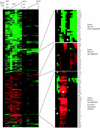Answering the Call: Coping with DNA Damage at the Most Inopportune Time
- PMID: 12488586
- PMCID: PMC153787
- DOI: 10.1155/S1110724302202016
Answering the Call: Coping with DNA Damage at the Most Inopportune Time
Abstract
DNA damage incurred during the process of chromosomal replication has a particularly high possibility of resulting in mutagenesis or lethality for the cell. The SOS response of Escherichia coli appears to be well adapted for this particular situation and involves the coordinated up-regulation of genes whose products center upon the tasks of maintaining the integrity of the replication fork when it encounters DNA damage, delaying the replication process (a DNA damage checkpoint), repairing the DNA lesions or allowing replication to occur over these DNA lesions, and then restoring processive replication before the SOS response itself is turned off. Recent advances in the fields of genomics and biochemistry has given a much more comprehensive picture of the timing and coordination of events which allow cells to deal with potentially lethal or mutagenic DNA lesions at the time of chromosomal replication.
Figures

References
-
- Radman M. Phenomenology of an inducible mutagenic DNA repair pathway in Escherichia coli: SOS repair hypothesis. In: Prakash L, Sherman F, Miller M, Lawrence C, Tabor H W, editors. Molecular and Environmental Aspects of Mutagenesis. Charles C Thomas; Springfield, Ill: 1999. pp. 128–142.
-
- Friedberg E C, Walker G C, Siede W. ASM Press; Washington, D.C.: 1995. DNA Repair and Mutagenesis.
-
- Koch W H, Woodgate R. The SOS response. In: Nickoloff J A, Hoekstra M F, editors. DNA Damage and Repair: DNA Repair in Prokaryotes and Lower Eukaryotes. Humana Press; Totowa, NJ: 1998. pp. 107–134.
-
- Sassanfar M, Roberts J W. Nature of the SOS-inducing signal in Escherichia coli. The involvement of DNA replication. J Mol Biol. 1990;212(1):79–96. - PubMed
LinkOut - more resources
Full Text Sources
Miscellaneous

